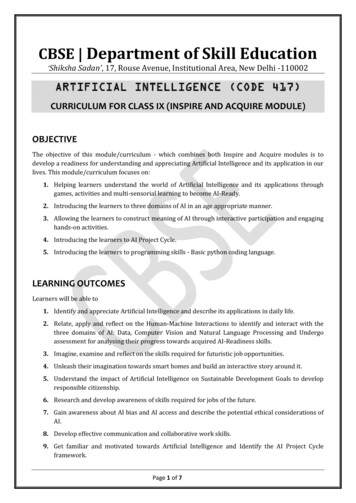
Transcription
CBSE Department of Skill Education‘Shiksha Sadan’, 17, Rouse Avenue, Institutional Area, New Delhi -110002ARTIFICIAL INTELLIGENCE (CODE 417)CURRICULUM FOR CLASS IX (INSPIRE AND ACQUIRE MODULE)OBJECTIVEThe objective of this module/curriculum - which combines both Inspire and Acquire modules is todevelop a readiness for understanding and appreciating Artificial Intelligence and its application in ourlives. This module/curriculum focuses on:1. Helping learners understand the world of Artificial Intelligence and its applications throughgames, activities and multi-sensorial learning to become AI-Ready.2. Introducing the learners to three domains of AI in an age appropriate manner.3. Allowing the learners to construct meaning of AI through interactive participation and engaginghands-on activities.4. Introducing the learners to AI Project Cycle.5. Introducing the learners to programming skills - Basic python coding language.LEARNING OUTCOMESLearners will be able to1. Identify and appreciate Artificial Intelligence and describe its applications in daily life.2. Relate, apply and reflect on the Human-Machine Interactions to identify and interact with thethree domains of AI: Data, Computer Vision and Natural Language Processing and Undergoassessment for analysing their progress towards acquired AI-Readiness skills.3. Imagine, examine and reflect on the skills required for futuristic job opportunities.4. Unleash their imagination towards smart homes and build an interactive story around it.5. Understand the impact of Artificial Intelligence on Sustainable Development Goals to developresponsible citizenship.6. Research and develop awareness of skills required for jobs of the future.7. Gain awareness about AI bias and AI access and describe the potential ethical considerations ofAI.8. Develop effective communication and collaborative work skills.9. Get familiar and motivated towards Artificial Intelligence and Identify the AI Project Cycleframework.Page 1 of 7
10. Learn problem scoping and ways to set goals for an AI project and understand the iterative natureof problem scoping in the AI project cycle.11. Brainstorm on the ethical issues involved around the problem selected.12. Foresee the kind of data required and the kind of analysis to be done, identify data requirementsand find reliable sources to obtain relevant data.13. Use various types of graphs to visualise acquired data.14. Understand, create and implement the concept of Decision Trees.15. Understand and visualise computer’s ability to identify alphabets and handwritings.16. Understand and appreciate the concept of Neural Network through gamification and learn basicprogramming skills through gamified platforms.17. Acquire introductory Python programming skills in a very user-friendly format.UNIT WISE DISTRIBUTIONUNIT12NAME OF THE UNITSUB-UNITDURATIONPERIODSExcite2 Hours 40 Mins.4 PeriodsRelate02 Hours3 PeriodsPurpose02 HoursPossibilities02 HoursAI Ethics3 Hours 20 Mins.5 PeriodsProblem Scoping14 Hours21 PeriodsData Acquisition02 Hours3 PeriodsData Exploration04 Hours6 PeriodsModelling06 Hours9 PeriodsINTRODUCTION TO AI3 Periods3 PeriodsAI PROJECT CYCLE3NEURAL NETWORK04 Hours6 Periods4INTRODUCTION TOPYTHON70 Hours105 PeriodsTOTALCBSE Department of Skill Education112 Hours168 PeriodsPage 2 of 7
COURSE OUTLINEUNITSUB-UNITSESSION / ACTIVITY / PRACTICALSession: Introduction to AI and setting up thecontext of the curriculumIce Breaker Activity: Dream Smart HomeideaLearners to design a rough layout of floorplan of their dream smart home.Recommended Activity: The AI GameLearners to participate in three games basedon different AI domains. INTRODUCTION TO AIExciteRelate Game 1: Rock, Paper and Scissors(based on data)Game 2: Mystery Animal (based onNatural Language Processing - NLP)Game 3: Emoji Scavenger Hunt (basedon Computer Vision - CV)LEARNING OUTCOMESTo identify and appreciateArtificial Intelligence anddescribe its applications indaily life.To relate, apply and reflecton the Human-MachineInteractions.To identify and interact withthe three domains of AI:Data, Computer Vision andNatural LanguageProcessing.Recommended Activity: AI Quiz (PaperPen/Online Quiz)To undergo an assessmentfor analysing progresstowards acquired AIReadiness skills.Recommended Activity: To write a letterWriting a Letter to one’s future self Learners to write a letter to self-keepingthe future in context. They will describewhat they have learnt so far or what theywould like to learn somedayTo imagine, examine andreflect on the skills requiredfor futuristic jobopportunities.Video Session: To watch a videoIntroducing the concept of Smart Cities,Smart Schools and Smart HomesLearners to relate toapplication of ArtificialIntelligence in their dailylives.Recommended Activity: Write anInteractive StoryLearners to draw a floor plan of aHome/School/City and write an interactivestory around it using Story Speakerextension in Google docs.CBSE Department of Skill EducationTo unleash theirimagination towards smarthomes and build aninteractive story around it.To relate, apply and reflecton the Human-MachineInteractions.Page 3 of 7
UNITSUB-UNITSESSION / ACTIVITY / PRACTICALSession: Introduction to sustainabledevelopment goalsPurposeRecommended Activity: Go Goals BoardGameLearners to answer questions on SustainableDevelopment GoalsSession: Theme-based research and CaseStudies Learners will listen to various casestudies of inspiring start-ups, companiesor communities where AI has beeninvolved in real-life. Learners will be allotted a theme aroundwhich they need to search for present AItrends and have to visualise the future ofAI in and around their respective theme.PossibilitiesRecommended Activity: Job Ad CreatingactivityLearners to create a job advertisement for afirm describing the nature of job availableand the skill-set required for it 10 years downthe line. They need to figure out how AI isgoing to transform the nature of jobs andcreate the Ad accordingly.LEARNING OUTCOMESTo understand the impact ofArtificial Intelligence onSustainable DevelopmentGoals to developresponsible citizenship.To research and developawareness of skills requiredfor jobs of the future.To imagine, examine andreflect on the skills requiredfor the futuristicopportunities.To develop effectivecommunication andcollaborative work skills.Video Session: Discussing about AI EthicsRecommended Activity: Ethics AwarenessStudents play the role of major stakeholdersand they have to decide what is ethical andwhat is not for a given scenario.AI EthicsTo understand and reflecton the ethical issues aroundAI.Session: AI Bias and AI Access Discussing about the possible bias in datacollection Discussing about the implications of AItechnologyTo gain awareness aroundAI bias and AI access.Recommended Activity: Balloon Debate Students divide in teams of 3 and 2 teamsare given same theme. One team goes inaffirmation to AI for their section whilethe other one goes against it. They have to come up with their points asto why AI is beneficial/harmful for thesociety.To let the students analysethe advantages anddisadvantages of ArtificialIntelligence.CBSE Department of Skill EducationPage 4 of 7
AI PROJECT CYCLEUNITSUB-UNITProblemScopingSESSION / ACTIVITY / PRACTICALLEARNING OUTCOMESSession: Introduction to AI Project Cycle Problem Scoping Data Acquisition Data Exploration Modelling EvaluationIdentify the AI Project Cycleframework.Activity: Brainstorm around the themeprovided and set a goal for the AI project. Discuss various topics within the giventheme and select one. List down/ Draw a mindmap of problemsrelated to the selected topic and chooseone problem to be the goal for the project.Learn problem scoping andways to set goals for an AIproject.Activity: To set actions around the goal. List down the stakeholders involved inthe problem. Search on the current actions taken tosolve this problem. Think around the ethics involved in thegoal of your project.Activity: Data and Analysis What are the data features needed? Where can you get the data? How frequent do you have to collect thedata? What happens if you don’t have enoughdata? What kind of analysis needs to be done? How will it be validated? How does the analysis inform the action?Presentation: Presenting the goal, actionsand data.Identify stakeholdersinvolved in the problemscoped.Brainstorm on the ethicalissues involved around theproblem selected.Understand the iterativenature of problem scopingfor in the AI project cycle.Foresee the kind of datarequired and the kind ofanalysis to be done.Share what the studentshave discussed so far.Activity: Introduction to data and its types. Identify data requirementsDataand find reliable sources toAcquisition Students work around the scenarios given to obtain relevant data.them and think of ways to acquire data.Session: Data VisualisationNeed of visualising dataWays to visualise data using various typesof graphical tools.Data Exploration CBSE Department of Skill EducationTo understand the purposeof Data VisualisationPage 5 of 7
UNITSUB-UNITSESSION / ACTIVITY / PRACTICALLEARNING OUTCOMESRecommended Activity: Let’s useGraphical Tools To decide what kind of data is requiredfor a given scenario and acquire the same. To select an appropriate graphical formatto represent the data acquired. Presenting the graph sketched.Use various types of graphsto visualise acquired data.Session: Decision TreeTo introduce basic structure of DecisionTrees to students.Recommended Activity: Decision TreeTo design a Decision Tree based on the datagiven.NEURAL NETWORKModellingRecommended Activity: Pixel It To create an “AI Model” to classifyhandwritten letters. Students develop a model to classifyhandwritten letters by diving thealphabets into pixels. Pixels are then joined together to analysea pattern amongst same alphabets and todifferentiate the different ones.Understand, create andimplement the concept ofDecision Trees.Understand and visualisecomputer’s ability toidentify alphabets andhandwritings.Session: Introduction to neural network Relation between the neural network andnervous system in human body Describing the function of neuralnetwork.Recommended Activity: Creating a HumanNeural Network Students split in four teams eachrepresenting input layer (X students),hidden layer 1 (Y students), hidden layer2 (Z students) and output layer (1student) respectively. Input layer gets data which is passed onto hidden layers after some processing.The output layer finally gets allinformation and gives meaningfulinformation as output.CBSE Department of Skill EducationUnderstand and appreciatethe concept of NeuralNetwork throughgamification.Page 6 of 7
UNITSUB-UNITSESSION / ACTIVITY / PRACTICALINTRODUCTION TO PYTHONRecommended Activity: Introduction toprogramming using Online Gaming portalslike Code Combat.LEARNING OUTCOMESLearn basic programmingskills through gamifiedplatforms.Session: Introduction to Python languageIntroducing python programming and itsapplicationsPractical: Python Basics Students go through lessons on PythonBasics(Variables, Arithmetic Operators,Expressions, Data Types - integer, float,strings, using print() and input()functions) Students will try some simple problemsolving exercises on Python Compiler.Acquire introductoryPython programming skillsin a very user-friendlyformat.Practical: Python Lists Students go through lessons on PythonLists (Simple operations using list) Students will try some basic problemsolving exercises using lists on PythonCompiler.SKILLS TO BE DEVELOPEDCBSE Department of Skill EducationPage 7 of 7
Introducing python programming and its Recommended Activity: Introduction to programming using Online Gaming portals like Code Combat. Learn basic programming skills through gamified platforms. Session: Introduction to Python language applications Acquire introductory Python programming skills in a very user-friendly format. Practical: Python .











